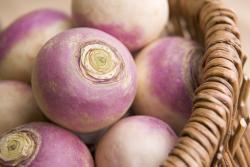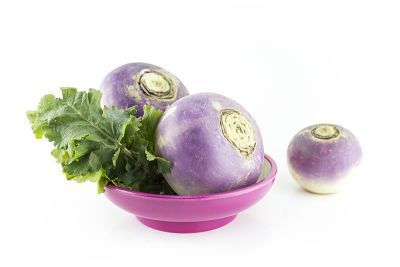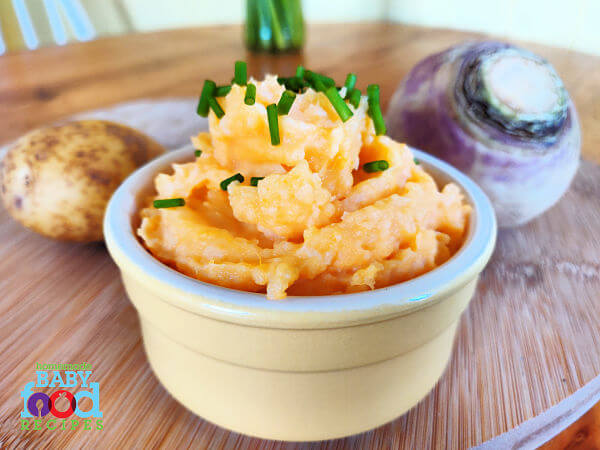Turnip Baby Food Recipes – Nutritious and Delicious Dishes!
Updated: Aug 17, 2023
Do you shy away from using turnips in your baby food recipes?
If so, is that because YOU dislike them… so you think your baby will too?
Then read on – because turnips really CAN be delicious if you know just how to choose and prepare them.

On this page we’re going to share with you some easy but truly tempting turnip recipes.
And hopefully we’ll convince you that those waterlogged (and, frankly, evil smelling!) veggies you may recall from your childhood are NOT what you’ll be serving up to your baby food connoisseur!
NOTE: Remember to check with your doctor before introducing turnips to your baby.
The information provided here is for guidance only and does not replace professional medical advice.
The goodness of turnips
Turnips – which are cruciferous vegetables related to broccoli and cabbage – contain plenty of vitamins and minerals to enhance your baby’s diet.
Rich in vitamins A and C, turnips also provide
- calcium
- fibre
- iron
- B vitamins
- folate
- potassium
They contain phytonutrients, those important compounds that are believed to help prevent cancer.
What’s more, some people find that eating turnips can help relieve congestion, probably because of their high vitamin C content.
So a nice turnip puree may be just what the doctor ordered if your little one is suffering from a cold (more tips here for feeding a congested baby).
Some people have even reported some relief from the symptoms of asthma after eating turnips, another potential benefit to take into account!
Don’t let the reputation of turnips put you off!
Unfortunately, turnips have the reputation of being bitter and rather smelly!
It’s true that larger, older turnips can produce quite an ‘aroma’ whilst they’re cooking and have a fairly pungent flavour that some may find unpleasant.
However, the secret is to ONLY buy turnips that are young and small – around the size of a ping pong ball.
They taste MUCH sweeter than larger turnips, their texture is better and they produce barely any smell at all during cooking.
In fact, small turnips are SO good that they can be eaten raw (grated in a salad, for example); older turnips absolutely MUST be cooked.
Please note, though, that we don’t recommend introducing raw turnips to your baby – these can be saved for when he’s older and chewing well!
A good tip to eliminate bitterness in slightly larger turnips…
…is to cook them by boiling them in a little water, along with a peeled potato.
Any bitterness will be absorbed by the potato, which can then be discarded.
It’s also a good idea to boil larger turnips with the lid off.
The smelly gases produced will dissipate into the air, rather than being absorbed back into the veggie and affecting the flavour.
When can I introduce turnips to my baby?
Turnips can be introduced (with your doctor’s consent) from 6 months of age.
Some parents may be concerned that turnips cause gas (wind), although we’ve never found this to be a problem with young, sweet turnips.
Luckily for us, our babies have always loved them!
If, however, you feel that your baby is prone to gas, then you may wish to wait until later in baby’s first year to introduce them.
We actually think it’s a good idea to get your baby accustomed to the flavour of turnips quite early, as they have that earthy, ‘vegetable-y’ flavour that can be quite difficult to introduce to older children.
Our experience has been that including earthy vegetables like turnips and swede (rutabaga) early on has made our children very receptive to veggies in general… and not just the more popular ‘sweeter’ vegetables like carrots and sweet potato!
As with any new food, though, remember to introduce turnips separately, using the four day rule.
This will help you identify them as the cause of any potential digestive upset or reaction.
Choosing and storing turnips
As we mentioned earlier, selecting the perfect turnip is key to preparing turnip baby food recipes that your little one will actually enjoy!
In addition to being small, the ideal turnips to cook for your baby will have smooth skin and should not look at all shrivelled.
They should also have a nice, sweet aroma.
Turnips are usually creamy white in colour, with tinges of purple, green or even red!
People sometimes mistake turnips for swedes (rutabagas), but swedes tend to have a darker skin and their flesh is more orange in colour.
Swedes tend to be larger than turnips, too – and are always bigger than the very small turnips that we recommend seeking out for use in your baby food recipes.
Turnips are sometimes sold with their leaves (turnip greens) still attached.
These are edible and can be removed and cooked separately – but when they ARE attached to the turnip, make sure they are fresh and green and don’t look wilted.
Remove the greens from the turnips before storing them in the fridge, where they’ll keep for 7 to 10 days.
Preparing turnips for your baby
DO I NEED TO PEEL TURNIPS?
Young, small turnips don’t need to be peeled (although there are some situations where you may prefer to remove the skin – please see this page for more information about whether or not to peel fruits and vegetables for your baby).
If you buy larger turnips, then they MUST be peeled, because the skins will be tough and indigestible.
METHODS OF COOKING TURNIPS FOR YOUR BABY
Steaming
Remove the greens, peel if necessary and cut into dice.
Steam for 5 to 10 mins until tender (the smaller the dice, the faster they’ll cook).
Boiling
Prepare for cooking as above, then boil – uncovered – in a little water for 5 to 10 mins until tender.
If you are using larger turnips, try adding a potato to absorb the bitterness.
It’s also useful to change the water half-way through the cooking time.
Baking
Very young turnips can be baked whole at 375 deg F (180 deg C) for around 30 to 45 mins until tender.
Don’t peel them first; if you don’t want your baby to eat the skins, then slip them off once they’ve cooked – it’s easier than peeling them!
Roasting
Toss turnip dice in olive oil and roast for around 45 mins at 325 deg F (160 deg C).
Slow roasting at a low temperature really brings out the sweetness of the turnips – and roast turnip dice make a delicious finger food!
Sautéing
Saute diced turnips in olive oil – or even in a little chicken or vegetable broth – for 5 to 10 mins until tender.
TO MAKE A BASIC TURNIP PUREE FOR YOUR BABY…
Use any of the methods described above to cook the turnip, then puree in a food processor until smooth.
Add water, broth or breast milk/formula to thin the mixture if necessary.
You can pep up your puree with any of the following
- chives
- thyme
- tarragon
- cinnamon
- nutmeg
- grated Parmesan cheese
NOTES: Avoid cooking turnips in iron or aluminium cooking pots – it turns them an unappealing, dark colour.
You can also use turnips interchangeably with swede/rutabaga in your recipes.
Turnip baby food ideas
Once you’ve cooked up some turnips for your little one, here are some ideas to make them interesting for him and so delicious he’ll definitely want seconds!
- Mix pureed turnip with pureed parsnip and a blob of cream cheese – unbelievably tasty!
- Put pureed turnip in a small ovenproof dish, top with grated cheddar cheese and put under a grill/broiler until the cheese has melted and is a pale golden colour.
A great side dish or a meal in itself! - Add diced turnips to your soups, stews and casseroles.
- Mash cooked turnip with cooked sweet potatoes or carrots.
- Sweeten cooked, mashed turnips with homemade applesauce.
- Puree baby’s turnips with a clove or two of roasted garlic… mmm!
Turnip baby food recipes
Gingered Beefy Turnips
2 tbsp diced turnip
4 tbsp low sodium or homemade beef broth
pinch ground ginger
- Bring the beef broth to a boil in a small saucepan and add the turnip.
- Lower the heat and simmer very gently for 5 to 10 mins, until the dice are tender.
- Transfer the mixture to a blender, add the pinch of ginger and puree until smooth.
Sweet Potato and Turnip Soup
2 tbsp unsalted butter
3 small turnips, diced
1 small onion, peeled and chopped
1 medium sweet potato, peeled and chopped
2 tsp flour
16 fl oz (2 cups) low sodium or homemade vegetable broth
pinch nutmeg
4 fl oz (1/2 cup) milk (use whole milk, breastmilk/formula or – for extra creaminess – half and half/single cream)
- Heat the butter in a saucepan and add the turnip, onion and sweet potato.
- Cook, stirring, until the vegetables are tender (around 6 mins).
- Remove the vegetables from the pan with a slotted spoon and set aside.
- Remove the saucepan from the heat and stir in the flour.
- Next, slowly add the broth, stirring constantly.
- Return to the heat and cook over a moderate heat, stirring, until thickened (around 5 mins).
- Return the veggies to the pot and add the pinch of nutmeg. Simmer for another 10 mins until all the veggies are nice and soft.
- Transfer to a blender and puree until smooth. Return to the pan add stir in the milk (or cream).
- Heat through gently.
This recipe yields enough to share but you can freeze some if you prefer. We like to freeze it before adding the milk or cream.
Scalloped Potatoes and Turnips
1 medium potato (preferably red skinned), peeled and sliced
6 small turnips, sliced
2 tbsp unsalted butter
2 tbsp flour
12 fl oz (1 1/2 cups) whole milk
4 oz (1 cup) grated Cheddar cheese
- Preheat the oven to 400 deg F (200 deg C).
- Cook the potato and turnip slices in boiling water until almost tender (around 10 mins).
- Drain well.
- Grease a small oven-proof dish and layer the potato and turnip slices in the dish.
- In a small saucepan, melt the butter and stir in the flour.
- Gradually blend in the milk, then simmer for a couple of minutes until thickened slightly.
- Pour the sauce over the turnips, then sprinkle the grated cheese over the top.
- Bake in the oven for around 15 mins until the cheese is melted and golden.
- Serve as a meal for younger babies or a yummy side dish for older ones! Leftovers freeze well for up to one month.
Gourmet Carrots and Turnips
1 medium carrot, peeled and diced
3 small turnips, diced
1/2 small onion, chopped
1 tsp chopped, fresh parsley
1 oz (1/4 cup) grated Swiss cheese
olive oil
- Heat a little olive oil in a small frying pan and saute the onion until tender.
- Steam the carrot/turnip dice until tender.
- Puree the carrot and turnip together, then stir in the sauted onion and the parsley.
- Stir in the grated cheese whilst still warm and serve!
Sweet Turnip Trio
1 tbsp diced turnip
1/2 ripe pear, cored and diced
1 tbsp finely chopped onion
1 tbsp olive oil
- Heat the oil in a small frying pan and add all the ingredients.
- Saute, stirring constantly, until tender.
- Mash or puree together, adding breast milk or formula to thin if necessary.
Easy Peasy Apple and Turnip Mash
1/2 small apple, cored and diced
2 small turnips, diced
2 fl oz (1/4 cup) pure apple juice
pinch cinnamon
- Bring the apple juice to a simmer in a small saucepan.
- Add the apple and turnip dice and simmer until tender.
- Add the cinnamon and mash well.
Terrific Turnip Fries
- Simply cut turnips into ‘fry’ shapes and toss with olive oil and a dash of cumin.
- Roast at 375 deg F (180 deg C) for around 25 mins, until golden and tender.
- Cool and serve!
You may also like…
Potato and Turnip Puree with Pear (on our Vegetarian Baby Food Recipes page)
Cheesy Turnip Bake (from our blog)
from our blog…
Homemade baby food equipment…
Homemade baby food accessories
We hope that your baby enjoys these turnip baby food recipes. And if you have any tasty turnip baby food ideas of your own, please do let us know!



